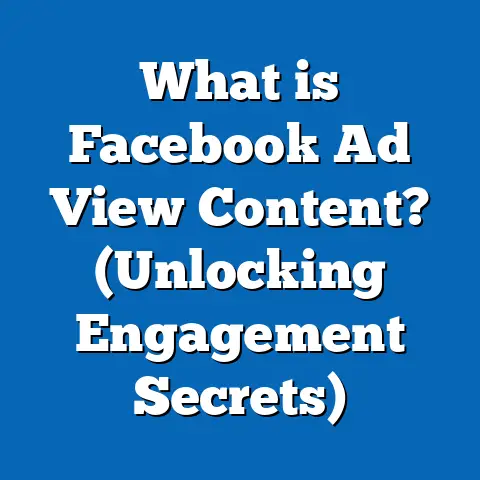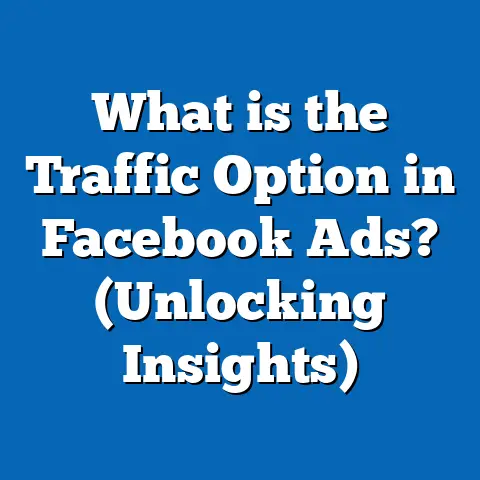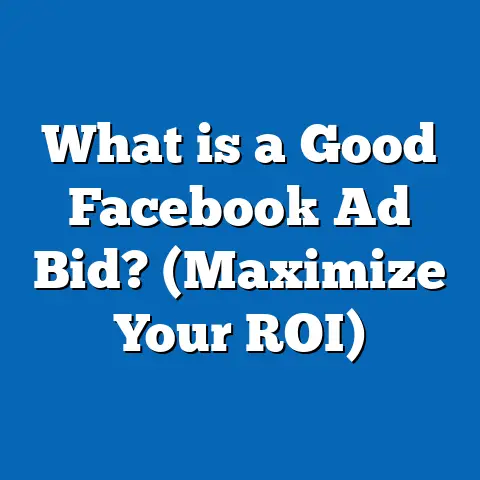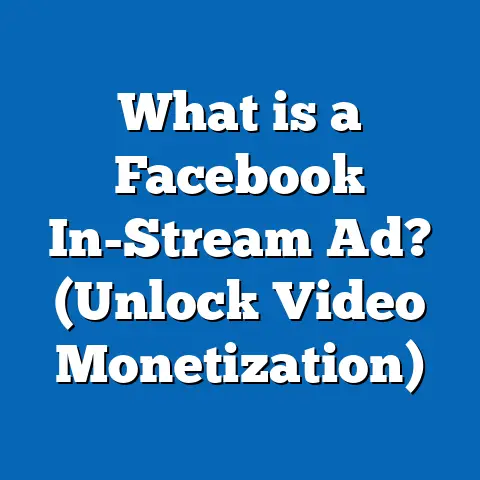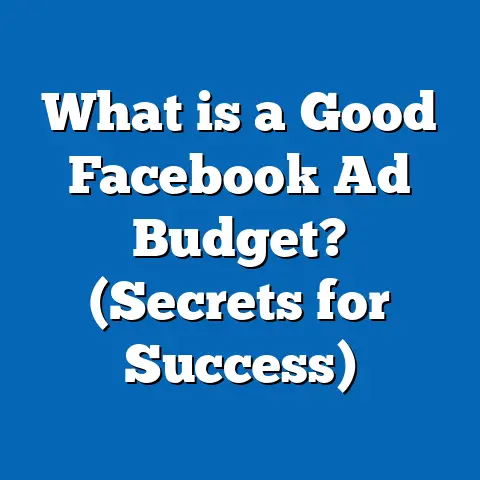What is Creative in Facebook Ads? (Unlocking Engagement Secrets)
What is Creative in Facebook Ads? (Unlocking Engagement Secrets)
Introduction: Why Creative Matters More Than Ever in Facebook Ads
Imagine scrolling through your Facebook feed late at night after a long day, craving something that catches your eye—a vibrant image, a funny video, or a compelling message. Suddenly, you pause. An ad stops your thumb mid-scroll. You watch, read, maybe even click or share. That moment of connection is what every advertiser strives for but few truly master. It’s the power of creative in Facebook ads—the magic that turns an everyday promotion into a memorable experience.
In today’s hyper-competitive digital world, where users are bombarded with thousands of ads daily, standing out isn’t optional; it’s essential. Your creative isn’t just the face of your campaign—it’s the core driver of engagement, clicks, and ultimately sales. Without strong creative, even the best-targeted ads and budgets fall flat.
The stakes are higher than ever. Facebook’s advertising platform continues to evolve rapidly, with new formats, stricter policies, and more competitive bidding. Marketers must understand the true meaning of creative and how to harness it effectively to unlock engagement secrets that translate into real business results.
This guide will take you on a deep dive into everything you need to know about creative in Facebook ads—from basic definitions to advanced strategies, supported by data, case studies, and actionable tips. Whether you’re launching your first campaign or refining a mature strategy, this resource is designed to help you craft compelling creatives that cut through the noise.
Understanding Creative in Facebook Ads
What Does “Creative” Mean in Facebook Advertising?
In Facebook advertising, “creative” refers to the combination of visual and textual elements that make up an ad. It includes:
- Images: Single photos or graphics used in image ads.
- Videos: Short-form clips or longer videos to tell a story or demonstrate product use.
- Headlines: The main bold text to capture attention.
- Primary Text: The body copy offering details or persuasion.
- Call to Action (CTA): Buttons or prompts encouraging users to take an action.
- Ad Formats: Carousel ads, collection ads, slideshows, instant experiences—all formats that influence how creative is presented.
Creative is essentially the packaging that delivers your brand message and value proposition to the audience. It’s what users see and interact with on their feeds or stories.
The Role of Creative in Facebook’s Algorithm
Facebook’s ad delivery system heavily factors user engagement signals—likes, comments, shares, clicks—when deciding which ads to show more often. Creative quality directly influences these engagement rates. Ads with compelling creative receive better relevance scores and lower costs per result.
According to Facebook internal research:
- Ads with high-quality creative can reduce cost per acquisition (CPA) by up to 35%.
- Creative impacts ad frequency—the number of times an ad is shown to the same user—and helps avoid ad fatigue.
Why Creative Is More Important Now Than Ever
Several trends have made creative critical in recent years:
- Increased Competition: Over 10 million advertisers are active on Facebook worldwide.
- Ad Saturation: The average user sees hundreds of ads daily.
- Changing User Behavior: Users scroll faster and are more selective about what they engage with.
- Algorithm Updates: Facebook prioritizes user experience, rewarding engaging content.
These dynamics mean that even perfectly targeted ads may fail without standout creative.
The Science Behind High-Performing Facebook Ad Creative
Emotional Appeal: Connecting Beyond Products
Humans make decisions emotionally and justify them logically afterward. Ads that evoke emotions like joy, surprise, fear of missing out (FOMO), or trust are far more effective than those focusing solely on product features.
Data Insight:
- According to Nielsen’s study on advertising effectiveness, emotionally charged ads perform twice as well in driving sales compared to purely rational messages.
- Emotional ads also generate 23% higher engagement rates on Facebook (Facebook IQ).
Example:
A charity campaign using heartfelt storytelling about individuals impacted by donations led to a 300% increase in click-through rates versus generic donation appeals.
Visual Hierarchy: Guiding the Eye
Visual hierarchy refers to how design elements are arranged to control the flow of attention. Effective creatives use contrast, size, color, and placement strategically:
- Large headlines draw immediate attention.
- Faces and eye direction guide viewers deeper into the ad.
- A clear CTA button stands out as the final point of action.
Research shows that ads with strong visual hierarchy have up to a 40% higher message recall (UX Design Institute).
Storytelling: Creating a Narrative That Resonates
Humans are wired for stories. Ads that tell a story create context and emotional resonance that pure facts cannot match.
Study: Stanford Graduate School of Business found stories increase memory retention by up to 22 times compared to plain data.
Practical Tip: Use customer testimonials or “before and after” scenarios in video ads to create relatable stories.
Personalization: Speaking Directly to Your Audience
Facebook’s targeting options allow marketers to segment audiences finely—by age, interests, behavior, location, and more. Tailoring creative for these segments dramatically increases relevance.
Stats:
- Personalized ads receive 2X higher CTRs compared to generic ones (Epsilon).
- Dynamic Creative Ads on Facebook automate this process by mixing different creative components for segmented audiences.
Components of Effective Facebook Ad Creative
Visual Elements Breakdown
Images
Images must be:
- High resolution (at least 1080 x 1080 pixels).
- Relevant and authentic; avoid generic stock photos.
- Consistent with brand style (colors, tone).
Effective Image Types:
- Product-in-use shots increase purchase intent.
- Lifestyle images create emotional connections.
- Close-ups highlight details or quality.
Videos
Video is the top-performing format on Facebook due to its immersive nature.
Best Practices:
- Keep videos short (15 seconds or less) for maximum retention.
- Use captions—80% of Facebook video views happen without sound.
- Start with an engaging hook within the first 3 seconds.
- Show product benefits clearly.
Carousel & Collection Ads
These formats allow showing multiple products or features in one ad unit.
Benefits:
- Carousel ads increase CTR by 72% (AdEspresso).
- Collection ads create immersive mobile shopping experiences directly within Facebook.
Colors and Fonts
Use contrasting colors for readability; stick to 1-2 fonts for clarity. Colors should evoke brand personality—blue suggests trust, red urgency, green calm.
Textual Elements Breakdown
Headline
Your headline needs to be concise yet compelling—ideally under 40 characters for mobile display. It should focus on benefits or urgency.
Primary Text
This is your chance to expand on the headline but keep it short (~125 characters recommended). Use simple language and include social proof if possible (“Join 10k happy customers”).
Call to Action (CTA)
Common CTAs include “Shop Now,” “Learn More,” “Sign Up.” Choose based on campaign goals. Strong CTAs increase conversion rates by up to 80% (HubSpot).
Creating Facebook Ad Creative That Converts: Step-by-Step Guide
Step 1: Deep Audience Research
Use Facebook Audience Insights and external tools like Google Analytics or survey apps. Understand:
- Demographics: Age, gender, location.
- Interests: Pages liked, hobbies.
- Behaviors: Purchase habits, device usage.
Create buyer personas representing your core customers. Tailor your creative message specifically for these groups.
Step 2: Develop Visual Storytelling Concepts
Translate audience insights into visual storyboards:
- What problems does your audience face?
- How does your product solve these problems?
For example, a fitness brand might show a user struggling with workouts before using their product and then succeeding afterward.
Step 3: Produce High-Quality Assets
Invest in professional photography and videography when possible. Authenticity matters more than polish but poor visuals can damage brand perception.
Step 4: Craft Clear and Persuasive Copy
Write headlines and body text focusing on benefits—not just features. Use emotional triggers identified earlier (fear of missing out, joy).
Step 5: Test Multiple Versions with A/B Testing
Facebook’s split testing tools allow you to test variations of images/videos, headlines, primary text, and CTAs.
Tips:
- Change one variable at a time for clear insights.
- Run tests long enough for statistical significance (usually 3–7 days).
Step 6: Optimize for Mobile Experience
Check ad previews on different devices before launch. Ensure fast loading times by compressing images/videos without sacrificing quality.
Case Studies: Real Brands Unlocking Engagement Through Creative
Case Study 1: Fashion Brand’s Video Campaign Drives Sales by 40%
A mid-sized online fashion retailer launched a series of lifestyle video ads featuring diverse models wearing their latest collection in relatable settings like coffee shops and parks. They combined this with personalized headlines tailored by age group.
Results:
- 40% increase in CTR over previous static image campaigns.
- 25% reduction in CPC.
- Positive user comments increased social proof organically.
Case Study 2: Local Restaurant Boosts Reservations by Using Carousel Ads
A local restaurant used carousel ads featuring high-quality photos of their top dishes paired with prices and customer ratings. This allowed potential customers to “browse” inside the ad without leaving Facebook.
Results:
- 60% increase in reservation clicks.
- Higher conversion rate compared to single image ads.
Case Study 3: SaaS Company Increases Trial Sign-Ups with Dynamic Creative Ads
A software company used Facebook’s dynamic creative feature to automatically pair different headlines, images, and CTAs targeting various industries they serve.
Results:
- Identified best-performing combinations within days.
- Increased free trial sign-ups by 33%.
- Reduced CPA by 20%.
Comparing Facebook Ad Creative With Other Platforms
| Platform | Creative Focus | Strengths | Limitations |
|---|---|---|---|
| Visual & text mix; versatile formats | Highly customizable; advanced targeting | Competitive bidding; algorithm changes | |
| Visual storytelling & influencer content | Strong engagement on visuals & stories | Younger demographic focus | |
| Google Ads | Text & search intent | High intent traffic; keyword focused | Less creative freedom; mostly text |
| Professional tone & B2B content | Effective for lead gen & professional services | Higher CPC; less visual impact |
Facebook’s advantage lies in its diverse ad formats allowing marketers to combine images, videos, carousels, dynamic elements while targeting very specific audiences at scale.
Advanced Tips for Mastering Facebook Ad Creative
Leverage Dynamic Creative Ads for Automation
Dynamic creative ads allow marketers to upload multiple images/videos/headlines/CTAs. Facebook’s machine learning then serves combinations optimized for performance automatically. This saves time and uncovers winning combinations you might not test manually.
Incorporate User Generated Content (UGC)
Featuring real customers using your product increases authenticity and trustworthiness significantly—people trust peer content more than brand messaging.
Data Point: Nielsen reports UGC-based ads can lead to conversion rates up to four times higher than traditional ads.
Use Interactive Elements Like Polls & Instant Experiences
Interactive formats invite users to actively engage rather than passively consume content. Polls or quizzes encourage participation while instant experiences create immersive mobile-first environments that boost dwell time.
Common Mistakes Marketers Make With Facebook Ad Creative
- Text Overload: Facebook limits text overlay on images to ~20%. Violating this lowers reach drastically.
- Generic Stock Photos: These fail to connect emotionally or differentiate brands.
- Ignoring Mobile Optimization: Most users access via mobile; poorly optimized creatives lose attention quickly.
- Not Refreshing Creatives: Running the same creative repeatedly causes ad fatigue leading to declining performance.
- Misaligned Creative & Objective: For example, awareness campaigns need emotional storytelling while conversion campaigns need clearer CTAs.
Measuring and Improving Your Creative’s Impact Over Time
Key Metrics To Track Consistently:
| Metric | Why It Matters | Target Range* |
|---|---|---|
| Click-through rate (CTR) | Measures interest & relevance | >1% (varies by industry) |
| Conversion rate | Tracks final action completion | Depends on goal; e.g., >5% good |
| Cost per acquisition (CPA) | Efficiency of spend | Lower is better; benchmark varies |
| Engagement rate | Likes/comments/shares indicate appeal | Higher rates mean better resonance |
| Frequency | How often same user sees ad | Keep <3–4 to avoid fatigue |
*Targets vary widely by industry and campaign type.
Tools For Measurement:
- Facebook Ads Manager: Detailed performance dashboards.
- Google Analytics: Tracks traffic & conversions from Facebook campaigns.
- Third-party tools: Like Hootsuite Ads or AdEspresso for enhanced reporting.
Regularly review these metrics and refine your creative based on findings—drop underperformers quickly and scale winners.
Future Trends in Facebook Ad Creative
AI-Powered Creative Generation
Artificial intelligence is increasingly used to generate personalized creative assets at scale—from auto-generated videos based on product feeds to predictive analytics suggesting best creative elements before launch.
Augmented Reality (AR) Ads
Facebook is expanding AR ad formats where users can interact with virtual objects through their camera—offering immersive product try-ons or experiences directly within the app.
Short-form Video Dominance
Following TikTok’s rise, Facebook prioritizes short-form videos (Reels). Marketers must adapt by creating punchy videos optimized for quick consumption.
Conclusion: Unlocking Engagement Through Better Creative
Creative is no longer just one element of your Facebook advertising—it’s the foundation that determines success or failure. It influences every stage of the funnel from grabbing attention in crowded feeds to persuading action at checkout.
The path forward requires combining data-driven insights with creative intuition:
- Understand your audience deeply through research.
- Craft emotionally resonant stories using strong visuals and copy.
- Regularly test new formats and messages.
- Optimize relentlessly for mobile-first experiences.
By mastering these principles and avoiding common pitfalls, you can unlock the engagement secrets hidden inside every successful Facebook ad campaign. Strong creative means stronger results—more clicks, conversions, loyalty—and ultimately business growth.
Additional Resources & Next Steps for Marketers
- Downloadable Templates: Ad creative planning sheets for images/videos/headlines/CTAs.
- Creative Testing Checklist: Step-by-step guide for running effective A/B tests.
- Top Tools List: Recommended software for design (Canva/Adobe), video editing (Premiere Pro), analytics (Facebook Analytics).
- Creative Inspiration Gallery: Examples from top-performing campaigns across industries.
- Training Webinars: Workshops focused on storytelling and video production skills for marketers.
If you want me to develop any of these resources or expand this guide further into workshop-style content or templates, just ask!

